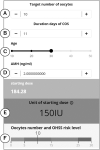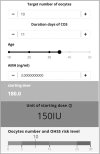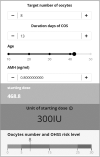The gonadotropins starting dose calculator, which can be adjusted the target number of oocytes and stimulation duration days to achieve individualized controlled ovarian stimulation in Japanese patients
- PMID: 36699956
- PMCID: PMC9853467
- DOI: 10.1002/rmb2.12499
The gonadotropins starting dose calculator, which can be adjusted the target number of oocytes and stimulation duration days to achieve individualized controlled ovarian stimulation in Japanese patients
Abstract
Purpose: To create a gonadotropin starting dose calculator for controlled ovarian stimulation, which can adjust the target number of oocytes and stimulation duration for each facility to achieve individualized controlled ovarian stimulation among the Japanese patients.
Methods: The patients received controlled ovarian stimulation using the gonadotropin-releasing hormone antagonist protocol, and oocytes were retrieved. Using single regression analysis, we selected age, anti-Müllerian hormone (AMH), and initial serum follicle-stimulating hormone as variables to predict the number of oocytes retrieved per gonadotropin dose (oocyte sensitivity index). Each variable was then analyzed using backward stepwise multiple regression.
Results: Age and AMH were selected as predictive variables from the backward stepwise multiple regression, and we developed a multiple regression equation. We decomposed the equation as the number of oocytes retrieved/(gonadotropin starting dose × stimulation duration days) and created a calculation formula to predict the gonadotropin starting dose from the target number of oocytes and stimulation duration days.
Conclusions: This is the first study to develop an individualized dosing algorithm for gonadotropins among Japanese patients. Our calculator will improve controlled ovarian stimulation performance and enable national standardization by allowing all physicians, regardless of their years of experience, to determine the appropriate starting dose of gonadotropins equally.
Keywords: gonadotropins starting dose; individualized controlled ovarian stimulation; ovarian sensitivity index; stimulation duration; target number of oocytes.
© 2023 The Author. Reproductive Medicine and Biology published by John Wiley & Sons Australia, Ltd on behalf of Japan Society for Reproductive Medicine.
Conflict of interest statement
The authors declare no conflicts of interest associated with this article. All the procedures followed were in accordance with the ethical standards of the responsible committee on human experimentation (facilityal and national) and with the Helsinki Declaration of 1964 and its later amendments. Informed consent was obtained from all patients for being included in the study. This article does not contain any studies with animal subjects performed by any of the authors. The protocol for the research project, including human subjects, has been approved by a suitably constituted Ethics Committee, ‘Medical corporation Kobanawa Clinic ethic screening committee’.
Figures



Similar articles
-
Prior salpingectomy impairs the retrieved oocyte number in in vitro fertilization cycles of women under 35 years old without optimal ovarian reserve.PLoS One. 2022 May 4;17(5):e0268021. doi: 10.1371/journal.pone.0268021. eCollection 2022. PLoS One. 2022. PMID: 35507603 Free PMC article.
-
The addition of anti-Müllerian hormone in an algorithm for individualized hormone dosage did not improve the prediction of ovarian response-a randomized, controlled trial.Hum Reprod. 2017 Apr 1;32(4):811-819. doi: 10.1093/humrep/dex012. Hum Reprod. 2017. PMID: 28175316 Clinical Trial.
-
Anti-Müllerian hormone variability and its implications for the number of oocytes retrieved following individualized dosing with follitropin delta.Clin Endocrinol (Oxf). 2019 May;90(5):719-726. doi: 10.1111/cen.13956. Epub 2019 Mar 18. Clin Endocrinol (Oxf). 2019. PMID: 30801744 Clinical Trial.
-
The prevention of ovarian hyperstimulation syndrome.J Obstet Gynaecol Can. 2014 Nov;36(11):1024-1033. doi: 10.1016/S1701-2163(15)30417-5. J Obstet Gynaecol Can. 2014. PMID: 25574681 Review. English, French.
-
Ovarian hyperstimulation syndrome prevention strategies: individualizing gonadotropin dose.Semin Reprod Med. 2010 Nov;28(6):463-7. doi: 10.1055/s-0030-1265672. Epub 2010 Nov 16. Semin Reprod Med. 2010. PMID: 21082504 Review.
Cited by
-
Verification of the utility of the gonadotropin starting dose calculator in progestin-primed ovarian stimulation: A comparison of empirical and calculated controlled ovarian stimulation.Reprod Med Biol. 2024 May 31;23(1):e12586. doi: 10.1002/rmb2.12586. eCollection 2024 Jan-Dec. Reprod Med Biol. 2024. PMID: 38827517 Free PMC article.
-
Artificial Intelligence, Clinical Decision Support Algorithms, Mathematical Models, Calculators Applications in Infertility: Systematic Review and Hands-On Digital Applications.Mayo Clin Proc Digit Health. 2024 Aug 26;2(4):518-532. doi: 10.1016/j.mcpdig.2024.08.007. eCollection 2024 Dec. Mayo Clin Proc Digit Health. 2024. PMID: 40206524 Free PMC article. Review.
-
Development of a novel calculator to predict gonadotropin dose and oocyte yield in oocyte cryopreservation cycles.J Assist Reprod Genet. 2025 Feb;42(2):423-432. doi: 10.1007/s10815-024-03372-7. Epub 2025 Jan 7. J Assist Reprod Genet. 2025. PMID: 39775731
References
-
- Maheshwari A, McLernon D, Bhattacharya S. Cumulative live birth rate: time for a consensus? Hum Reprod. 2015;30(12):2703–7. - PubMed
-
- Vaughan DA, Leung A, Resetkova N, Ruthazer R, Penzias AS, Sakkas D, et al. How many oocytes are optimal to achieve multiple live births with one stimulation cycle? The one‐and‐done approach. Fertil Steril. 2017;107(2):397–404. - PubMed
-
- Polyzos NP, Drakopoulos P, Parra J, Pellicer A, Santos‐Ribeiro S, Tournaye H, et al. Cumulative live birth rates according to the number of oocytes retrieved after the first ovarian stimulation for in vitro fertilization/intracytoplasmic sperm injection: a multicenter multinational analysis including ∼15,000 women. Fertil Steril. 2018;110(4):661–70. - PubMed
-
- Wu CX, Zhang T, Shu L, Huang J, Diao FY, Ding W, et al. Cumulative live birth rates per oocytes retrieved cycle: evaluation of clinical outcomes of IVF/ICSI. Zhonghua Fu Chan Ke Za Zhi. 2018;53(3):160–6. - PubMed
LinkOut - more resources
Full Text Sources
